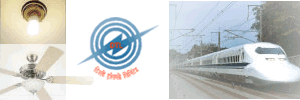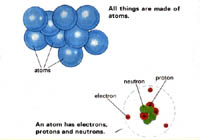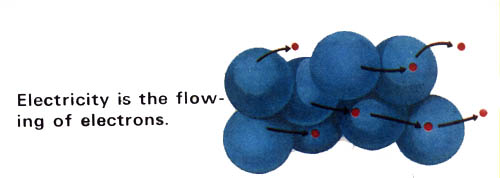
|
|
From Electrons to Electricity !
|
|
In everyday life we find bulbs in lampshades or fluorescent tubes all around us in houses, offices, restaurants etc.
You must have wondered what causes the bulb or the tube
to
light up ? " Actually they need the electricity to light up. Electricity passes
through wires that are attached to them and it makes the bulbs and
tubes glow.
|
|

|
|
|
WHAT IS ELECTRICITY?
|
|
All things are made up of very thin particles called atoms. Everything from
metals, wood, glass, water and gases are made of atoms.
We cannot see atoms because
they are
very,
very small. However, scientists have found out that even atoms
are made up of smaller particles. One of the many types of
particles in an atom is the electron.
|
|
We get electric current because of the
movement of the electrons. So, current is the flow of electrons. One might
imagine electrons traveling from one end of the wire to the
other
end and making a continuous flow, just like the flow of water in a pipe (
though the twoare not exactly identical ).
|


|
|
|
|
Electricity
travels along a path. If the path is blocked, then
electricity cannot keep flowing. The whole path along which electricity
travels is knownas a circuit. A broken path is
known as an 'Open
Circuit' and the electricity can not flow in an open
circuit.An unbroken path is known as a 'ClosedCircuit' and
the electricity can flow.
|
|
|
CONDUCTORS AND INSULATORS
|
|
Some materials allow electricity to flow
through them easily, some materials do not. The materials that allow
electricity to flow through them easily areknown as
conductors.
The
materials through which it is
difficult for electricity to flow are known as insulators
ornon- conductors. Conductors are useful to us
because they allow electricity to flow
through
them. However,
sometimes we do not want electricity
to flow, in certain instances. And so we
have to use insulators to prevent the flow
ofelectricity.For example we
use rubber or
plastic insulators to cover electric wires in order to prevent electricity form
flowing into our body. Otherwise we will get an electric shock. So
insulators are also
useful to us.
|
|
|
HOW TO TURN ELECTRICITY ON AND OFF
|
|
We use electricity very
often. We use electricity to work our radios, to run our fans, in electric
kettles to boil water and also to getlight from the bulb.
However, we do not
keep
our
radio 'on' all the time. And if it is cold, we do not want the fan to
keep running. After the water has boiled,we do not need
electricity any more. We definitely do not need to have the
light
'on' when it is very bright. Therefore we must have a way and a
device to turn electricity 'on' and 'off', whenever we need to.
We use a switch to turn
electricity 'on' and 'off'.
The function of the switch is mainly to 'make' or
'break' the circuit, thereby sometimes allowing the electricity to travel (ON
POSITION) and otherwise making the flow of electricity
stop (OFF
POSITION) .
|
|
|
OTHER WAYS TO OBTAIN ELECTRICITY ( BATTERIES )
|
There
are mainly two kinds of batteries namely primary and secondary. The primary
batteries we use are known as dry cells. Many other
types of dry cells are shown in the picture.
A dry cell
can give a steady current for a certain time after which the current
becomes weaker and weakerand finally it
produces no more current. It is of no use to us anymore.This
is
one type of battery.On the other hand, the secondary battery is known as wet cell. We
call it a wet cell because inside the cell there is liquid.
We also call the wet cellshown
below
'an
accumulator'. It can give us electricity for a longer time.
And when it becomes weak it starts giving lesser current,we
recharge it. After recharging the wet cell becomes
as good
as new and
starts giving normal current again.
|
 DRY CELL DRY CELL |
 WATER CELL WATER CELL |
|
|
|
HOW IS ELECTRICITY PRODUCED ( Generation of Electricity )
|
The electricity, which we use for
electric bulbs, fans, kettles and irons, is produced by 'generators'. A
generator is actually a very big dynamo. It can produce
a very large amount
of
electricity.
Number of generators produce power in Power Station. Electricity
produced at a power station isallowed to flow through
metallic cables, which run from the Power
Station to our houses and offices.
Then they run back from our houses andofficesto the power
station, forming a closed circuit ( remember the essential condition for
the flow
of current - the closed circuit ! ). Don't be
surprised if you don't
see many cables running from pole to pole, they can be laid underground too ! |
|
|
ELECTRICITY CAN GIVE US HEAT
|
Our common experience is that whenever we put our hand near a lighted electric bulb, we feel the heat coming from the bulb. Similarly, we can feel a touch of heat from a
lighted torch after sometime. Also if we switch on an electric kettle containing water the water starts boiling after sometime. Actually there is a long piece of coiled wire inside
the
kettle, when electricity passes through it, heat is produced which makes the water boil. |
|
|
ELECTRICITY CAN GIVE US liGHT
|
We notice that every time electricity is passed through the thin wire of a bulb, light is produced. We say that some of the electricity has been 'changed' to light. Actually, the
changing
of electricity into heat takes place first. The electricity that passes through the thin tungsten wire inside the bulb, makes the wire very hot. The wire becomes so
hot that is glows.When it glows, it gives off light. Similarly electricity is converted to light in a fluorescent lamp too.
But whereas a tungsten bulb uses up a lot of electricity before light is produced, a fluorescent lamp uses up only a small amount of electricity to produce light. Therefore for
the same
amount of electricity a fluorescent lamp gives off more light than a tungsten bulb.
|
|
|
ELECTRICITY IS A FORM OF ENERGY
|
Electricity can be converted into heat, light or magnetism. In fact electricity, heat, light and magnetism are all forms of energy. There are many more forms of energy. And they
can be
converted into one another. For example electrical energy can be changed to light energy, heat energy or magnetic energy.
|
|
| ELECTRICITY CAN PROVE TO BE FATAL TOO
|
|
Electricity is very useful to us in many ways.
We can use to make our lives more comfortable. But it can be very DANGEROUS to
us too. Here are a fewtips to stay away
from harm
- Do not touch a bare wire from the main
electrical circuit. It may be a live wire i.e. electricity might be
traveling through it. If you touch it, the electricity will
flow into your body
and might give you an electric shock.
- Climbing a lamppost carrying electric wires is
dangerous. A lamppost is usually made of metal and is therefore a good
conductor of electricity. Some electricity may escape
from the electric wires
to the lamppost and so you could be electrocuted.
- Do not push a needle through an electric wire.
An electric wire is covered by rubber or plastic insulators. If you do so,
electric current will flow through the needle to your
body and give you a
shock .
- Do not try to repair electrical appliances.
Leave it to an electrician.
- Touching an electrical appliance with wet
hands is dangerous ! Water can conduct electricity.
Ask an
electrician to educate you about electrical safety.
|
|
|
MEASUREMENT OF ELECTRICITY
|
|
Electric current in a wire is something like water current in a pipe.
The amount of electricity passing through the wire per
second is measured in ampere (A).
The "pressure" pushing the electricity along the wire is
measured in Volt (V). For example a torch battery is 1½ Volts,
a car battery is 6 Voltsor 12 Volts. Electricity
running in the
cables in your house is 240 volts.
The amount of
electrical energy used in homes, offices, etc. is measured by an electricity
meter in kilowatt-hours.
Watt is
the unit of power or rate of doing work. A kilowatt-hour is the
electrical energy supplied at a rate of 1,000 watts for
1 hour
|